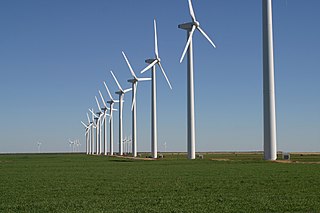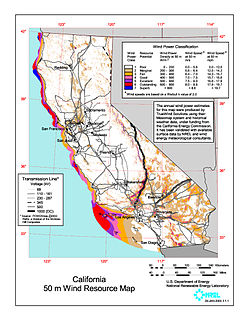The White Creek Wind Farm is an electricity generating wind farm facility in Klickitat County, Washington, United States. It is owned by Last Mile Electric Cooperative and began operations in 2007. The facility has a generating capacity of 205 megawatts. [1] [2]

Wind power is a branch of the energy industry that has expanded quickly in the United States over the last several years. From January through December 2021, 379.8 terawatt-hours were generated by wind power, or 9.23% of all generated electrical energy in the United States. The average wind turbine generates enough electricity in 46 minutes to power the average US home for one month. In 2019, wind power surpassed hydroelectric power as the largest renewable energy source generated in the U.S.

Wind power in Texas, a portion of total energy in Texas, consists of over 150 wind farms, which together have a total nameplate capacity of over 30,000 MW. If Texas were a country, it would rank fifth in the world: The installed wind capacity in Texas exceeds installed wind capacity in all countries but China, the United States, Germany and India. Texas produces the most wind power of any U.S. state. According to the Electric Reliability Council of Texas (ERCOT), wind power accounted for at least 15.7% of the electricity generated in Texas during 2017, as wind was 17.4% of electricity generated in ERCOT, which manages 90% of Texas's power. ERCOT set a new wind output record of nearly 19.7 GW at 7:19 pm Central Standard Time on Monday, January 21, 2019.

Wind power in California had initiative and early development during Governor Jerry Brown's first two terms in the late 1970s and early 1980s. The state's wind power capacity has grown by nearly 350% since 2001, when it was less than 1,700 MW. In 2016, wind energy supplied about 6.9% of California's total electricity needs, or enough to power more than 1.3 million households. Most of California's wind generation is found in the Tehachapi area of Kern County, California, with some large projects in Solano, Contra Costa and Riverside counties as well. California is among the states with the largest amount of installed wind power capacity. In recent years, California has lagged behind other states when it comes to the installation of wind power. It was ranked 4th overall for wind power electrical generation at the end of 2016 behind Texas, Iowa, and Oklahoma. As of 2019, California had 5,973 megawatts (MW) of wind power generating capacity installed.

The Wild Horse Wind Farm is a 273-megawatt wind farm that generates energy for Puget Sound Energy that consists of one hundred twenty seven 1.8-megawatt Vestas V80 turbines and twenty two 2.0-megawatt Vestas V80 turbines on a 10,800-acre (4,400 ha) site in Kittitas County, Washington, 17 miles (27 km) east of Ellensburg, Washington. The turbines are placed on the high open Shrub-steppe ridge tops of Whiskey Dick Mountain, which was chosen for its energetic wind resource, remote location, and access to nearby power transmission lines. The towers are 221 feet (67 m) tall, and each blade is 129 feet (39 m) long, with a total rotor diameter of 264 feet (80 m), larger than the wingspan of a Boeing 747. The turbines can begin producing electricity with wind speeds as low as 9 mph (14 km/h) and reach full production at 31 mph (50 km/h). They shut down at sustained wind speeds of 56 mph (90 km/h). The site is also home to one of the largest solar array (500 kW) in Washington.
The American Wind Energy Association (AWEA) is a Washington, D.C.–based national trade association formed in 1974, representing wind power project developers, equipment suppliers, service providers, parts manufacturers, utilities, researchers, and others involved in the wind industry.

At the end of 2015, the installed capacity of wind power in Washington was 3,075 megawatts (MW) with wind power accounting for 7,101 GWh. In 2016, it reached a generation of 8,041 GWh, comprising 7.1% of the electricity generated in the state. In 2019, it had a capacity of 3,085 MW, responsible for 7.33% of generation.

Wind power in Illinois provided nearly 10% of the state's generated electrical power in 2020 powering 1,231,900 homes. At the end of 2020, Illinois had 6,300 megawatts (MW) of wind power installed, ranking fifth among states for installed wind turbine capacity. An additional 1,100 MW of wind power was under construction across the state at the end of 2020.
Marengo Wind Farm is an electricity generating wind farm facility located near Dayton, Washington, United States. It is owned by PacifiCorp and began operations in 2007. The facility has a generating capacity of 140 megawatts.
The Hopkins Ridge Wind Farm is an electricity generating wind farm facility located in Columbia County, Washington, United States. It is owned by Puget Sound Energy and began operations in 2005, built by RES Americas, a part of the Renewable Energy Systems Group. After a second phase of construction in 2008, the facility has a generating capacity of 157 megawatts, up from 149 megawatts. In the past, the energy output of Hopkins Ridge and Wild Horse Wind Farm has been sold to various California utilities through power purchase agreements.
The Hay Canyon Wind Farm is an electricity generating wind farm facility located in Moro, Oregon, United States. It is owned by Iberdrola Renewables and began operations in 2009. The facility has a generating capacity of 101 megawatts. The farm sells power to the Snohomish County Public Utility District.
The Leaning Juniper Wind Project is an electricity generating wind farm facility located in Gilliam County, Oregon, United States with a total generating capacity of 301.5 megawatts. It is owned by PacifiCorp and began operations in 2006. Leaning Juniper I became operational in September 2006 with 67 1.5 MW wind turbines with a capacity of 100.5 megawatts. "Leaning Juniper II includes 133 GE 1.5 MW wind turbines with a capacity of 201 MW. This phase came online in 2011." The Jones Canyon Substation was built as part of this project and to support other wind projects in the area.
Wind power in Indiana was limited to a few small water-pumping windmills on farms until 2008 with construction of Indiana's first utility-scale wind power facility, Goodland with a nameplate capacity of 130 MW. As of September 2017, Indiana had a total of 1897 MW of wind power capacity installed, ranking it 12th among U.S. states. Wind power was responsible for 4.8% of in-state electricity production in 2016.

Wind power in Michigan is a developing industry. The industrial base from the automotive industry has led to a number of companies producing wind turbine parts in the state. The development of wind farms in the state, however, has lagged behind. In January 2021, there were a total of 1,481 wind turbines in the state with a nameplate capacity of 2,549 MW. The nameplate total exceeded 2,000 MW when Pine River came online in March 2019. Wind provided 4.2% of the state's electricity in 2016.

The state of South Dakota is a leader in the U.S. in wind power generation with over 30% of the state's electricity generation coming from wind in 2017. In 2016, South Dakota had 583 turbines with a total capacity of 977 megawatts (MW) of wind generation capacity. In 2019, the capacity increased to 1525 MW.

The U.S. State of Oklahoma has high potential capacity for wind power in the western half of the state. In 2017, Oklahoma's installed wind generation capacity was almost 7,500 megawatts, supplying almost a third of the state's generated electricity.

Wind power in Maryland, which has land-based and offshore resources, is in the early stages of development. As of 2016, Maryland has 191 megawatts (MW) of wind powered electricity generating capacity, responsible for 1.4% of in-state generated electricity. Two offshore wind farm projects that will supply wind-generated power to the state are underway.
Coordinates: 45°43′36″N120°50′02″W / 45.72667°N 120.83389°W